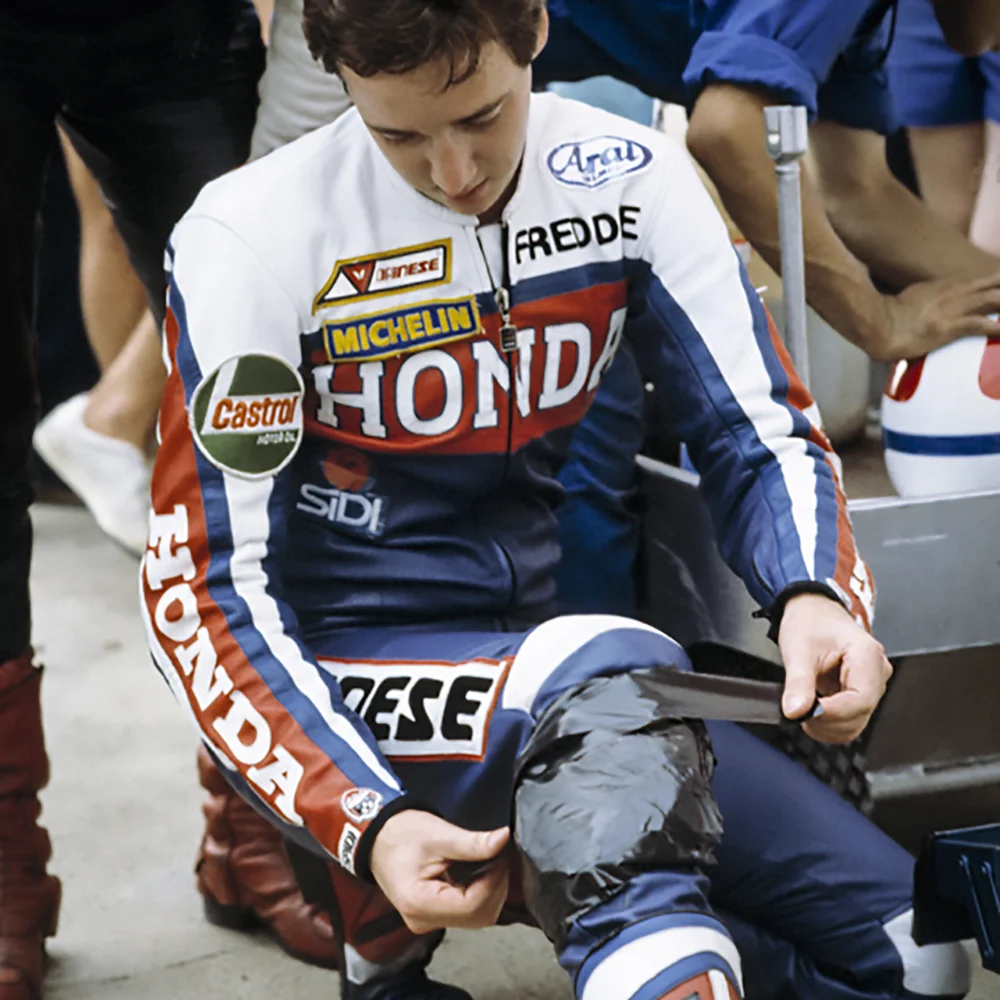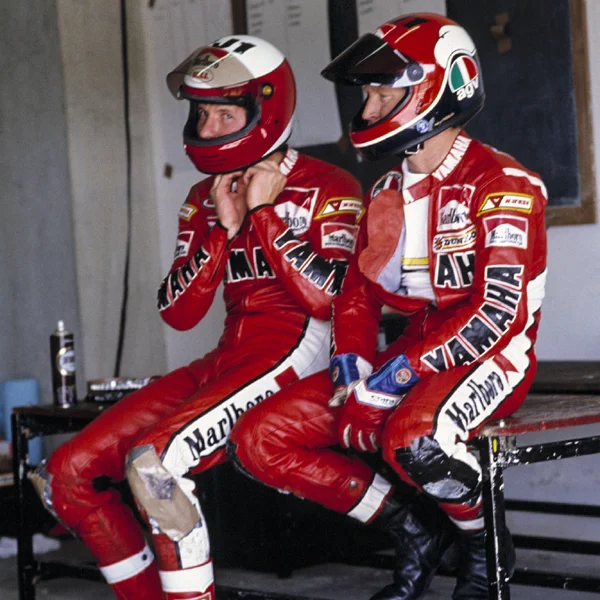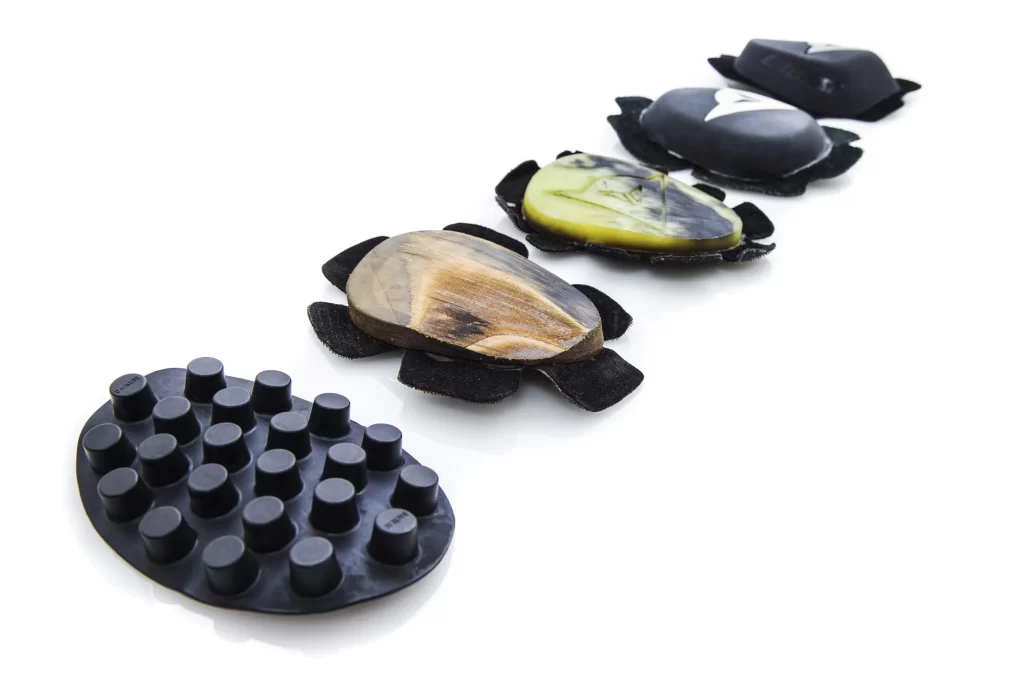It is a sight to behold is it not? A rider hanging onto a bike that is leaned way over, knee planted, elbow, even shoulder onto the track’s surface. It is made possible by the technological advances in tyres and motorcycle chassis, and also the unsung hero: The knee slider.
As with all things on the track, the knee slider went through a development process spanning several decades.
Why drag knees on the track?
Dragging the knee allows the rider to gauge how much lean angle he is carrying through a turn.
At the same time, having the torso, bum, and knee off to one side of the bike moves the rider’s centre of gravity (CoG) off the centreline of the bike, thus taking away the rider’s weight from being added to the centrifugal forces acting on the tyres’ contact patches. Too much centrifugal force will cause the tyres’ to wear out quickly and it is also easier for the tyres to lose grip.
Also, with the rider’s CoG off the to the side, the bike leans less in a corner compared to when the rider is sitting in the middle of the seat. This also boosts the tyres’ ability to grip, hence being able to carry more cornering speed and is also relatively safer.
And finally, the rider is able to use that knee to push the bike up ever so slightly off that front tyre’s band of contact patch when it starts to slide (some riders call it “push” or “close”).
When did knee sliding start?
If you see old motorcycle racing pictures prior to the late 70’s, you would see riders sitting straight up on their bikes in corners.
The person who popularised knee sliding on the track was the legendary “King” Kenny Roberts, Sr. Now, he was not the first to do so, because Jarno Saarinen who first did so. The Finnish rider began his career as an ice racer before migrating to road racing. Roberts then witnessed Saarinen moving his body off the centreline of the bike, sticking his knee out in corners, and sliding the rear tyre at the Ontario Motor Speedway in 1972.
Roberts was a dirt track rider himself and used to sliding the bike’s rear tyre, too. He decided to try out Saarinen’s technique, albeit exaggerating his body position by moving his body more off the bike. (Legend has it that he hurt one of his testicles during a dirt-bike crash, hence moving his body as such.) He immediately found that doing so settled down his bike and most famously, the veastly Yamaha TZ750 and the later TZ500 for the corners. Carrying more and more speed into the corners meant that his knee began to touch down on the track’s surface.
Other riders saw how successful he was and began copying his technique and the kneedown cornering technique was born.
Early knee sliders
Planting the knees in corners had the friction holing Robert’s leather suit. Besides that, leather does not slide well, and could grab the surface of the track. So he began wrapping the knee region with copious amounts of duct tape.

Then someone experimented by taping motorcycle helmet visors to their knees. Is slid smoother but also wore out quickly.

Bear in mind that racesuits had no provision for knee sliders up to this time. Then in 1981, Dainese stepped up by creating a suit with knee sliders stitched in. It had several plastic cylinders poking up from the base, and was dubbed the istrice (porcupine). It proved to be difficult to replace.

Several years later, a suit with Velcro knees pads was introduced. The knee slider was now made of harder leather. Easily replaceable, but not slippery enough for sliding.
In 1986, a new knee slider appeared. It was made of plastic and began to look oval-shaped like what we have now. But the true modern knee slider appeared in 1990 with the shape and materials we see today.
However, several riders continued to voice their objection as the plastic was too grippy. So, suit and knee slider makers kept working at improving the slider’s slipperiness and durability.
Into the new era
Modern knee sliders are made to several criteria: How slippery, how much feel is transmitted to the rider, durability, and, aerodynamics. Also available are rain knee sliders that are thicker so that riders do not lean their motorcycles as much as they do on a dry track.
Oh yeah, elbow sliders and even shoulder sliders are made of the same material.
So, spare a thought for the unassuming knee sliders.























